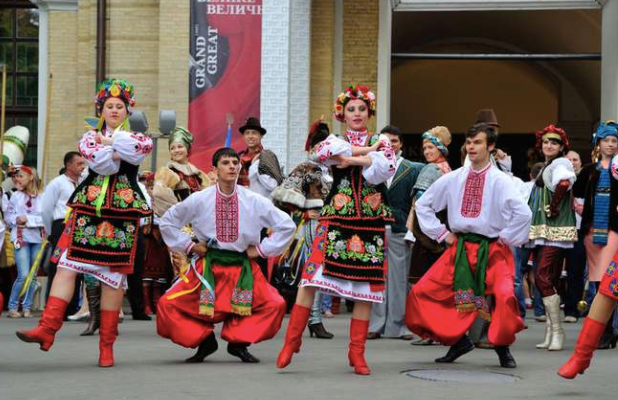Ukraine is a large country in Eastern Europe known for its Orthodox churches, Black Sea coastline and forested mountains. Its capital, Kiev, features the gold-domed St. Sophia’s Cathedral, with 11th-century mosaics and frescoes. Overlooking the Dnieper River is the Kiev Pechersk Lavra monastery complex, a Christian pilgrimage site housing Scythian tomb relics and catacombs containing mummified Orthodox monks.
Ukraine, a country located in eastern Europe, the second largest on the continent after Russia. The capital is Kyiv (Kiev), located on the Dnieper River in north-central Ukraine.

A fully independent Ukraine emerged only late in the 20th century, after long periods of successive domination by Poland-Lithuania, Russia, and the Union of Soviet Socialist Republics (U.S.S.R.). Ukraine had experienced a brief period of independence in 1918–20, but portions of western Ukraine were ruled by Poland, Romania, and Czechoslovakia in the period between the two World Wars, and Ukraine thereafter became part of the Soviet Union as the Ukrainian Soviet Socialist Republic (S.S.R.). When the Soviet Union began to unravel in 1990–91, the legislature of the Ukrainian S.S.R. declared sovereignty (July 16, 1990) and then outright independence (August 24, 1991), a move that was confirmed by popular approval in a plebiscite (December 1, 1991). With the dissolution of the U.S.S.R. in December 1991, Ukraine gained full independence. The country changed its official name to Ukraine, and it helped to found the Commonwealth of Independent States (CIS), an association of countries that were formerly republics of the Soviet Union.
Ukraine is bordered by Belarus to the north, Russia to the east, the Sea of Azov and the Black Sea to the south, Moldova and Romania to the southwest, and Hungary, Slovakia, and Poland to the west. In the far southeast, Ukraine is separated from Russia by the Kerch Strait, which connects the Sea of Azov to the Black Sea.
Ukraine occupies the southwestern portion of the Russian Plain (East European Plain). The country consists almost entirely of level plains at an average elevation of 574 feet (175 metres) above sea level. Mountainous areas such as the Ukrainian Carpathians and Crimean Mountains occur only on the country’s borders and account for barely 5 percent of its area. The Ukrainian landscape nevertheless has some diversity: its plains are broken by highlands—running in a continuous belt from northwest to southeast—as well as by lowlands.
The rolling plain of the Dnieper Upland, which lies between the middle reaches of the Dnieper (Dnipro) and Southern Buh (Pivdennyy Buh, or the Boh) rivers in west-central Ukraine, is the largest highland area; it is dissected by many river valleys, ravines, and gorges, some more than 1,000 feet (300 metres) deep. On the west the Dnieper Upland is abutted by the rugged Volyn-Podilsk Upland, which rises to 1,545 feet (471 metres) at its highest point, Mount Kamula. West of the Volyn-Podilsk Upland, in extreme western Ukraine, the parallel ranges of the Carpathian Mountains—one of the most picturesque areas in the country—extend for more than 150 miles (240 km). The mountains range in height from about 2,000 feet (600 metres) to about 6,500 feet (2,000 metres), rising to 6,762 feet (2,061 metres) at Mount Hoverla, the highest point in the country. The northeastern and southeastern portions of Ukraine are occupied by low uplands rarely reaching an elevation of 1,000 feet (300 metres).
Among the country’s lowlands are the Pripet Marshes (Polissya), which lie in the northern part of Ukraine and are crossed by numerous river valleys. In east-central Ukraine is the Dnieper Lowland, which is flat in the west and gently rolling in the east. To the south, another lowland extends along the shores of the Black Sea and the Sea of Azov; its level surface, broken only by low rises and shallow depressions, slopes gradually toward the Black Sea. The shores of the Black Sea and the Sea of Azov are characterized by narrow, sandy spits of land that jut out into the water; one of these, the Arabat Spit, is about 70 miles (113 km) long but averages less than 5 miles (8 km) in width.
The southern lowland continues in the Crimean Peninsula as the North Crimean Lowland. The peninsula—a large protrusion into the Black Sea—is connected to the mainland by the Perekop Isthmus. The Crimean Mountains form the southern coast of the peninsula. Mount Roman-Kosh, at 5,069 feet (1,545 meters), is the mountains’ highest point.
Ukraine possesses a wealth of cultural talent and a considerable cultural legacy. Numerous writers have contributed to the country’s rich literary history. Impressive monuments of architecture and museums displaying works by generations of Ukrainian artists can be found throughout the country, and art galleries featuring contemporary Ukrainian artists have become commonplace in larger urban centres. The country’s strong tradition of folk art also continues to this day. In addition, high-calibre performing artists and ensembles appear regularly in Ukraine’s numerous theatres and concert halls.
The social changes brought about by Ukrainian independence are most evident in the cities, particularly Kyiv. The country’s capital now boasts high-end stores catering to a moneyed class, and a fashionable strip of contemporary art galleries and cafés winds its way down the historical street of Andriyivskyi Uzviz. The capital’s renovated airport stands in striking contrast to its decidedly dour appearance in Soviet times.


